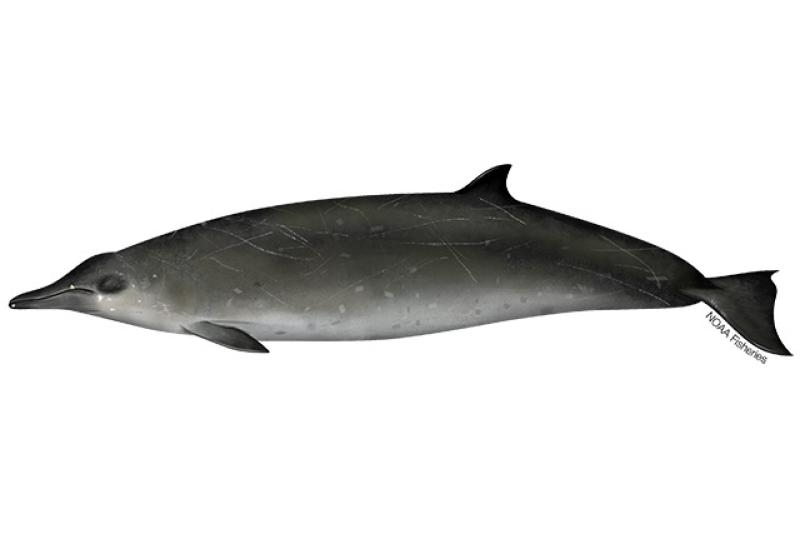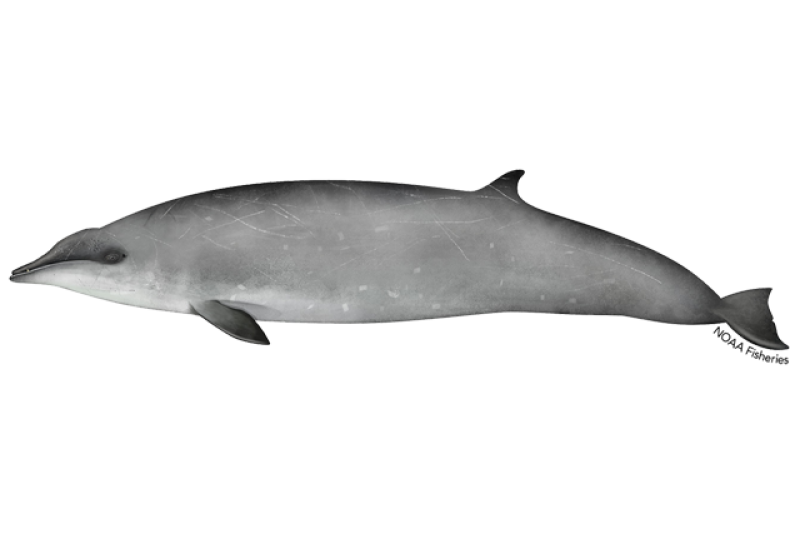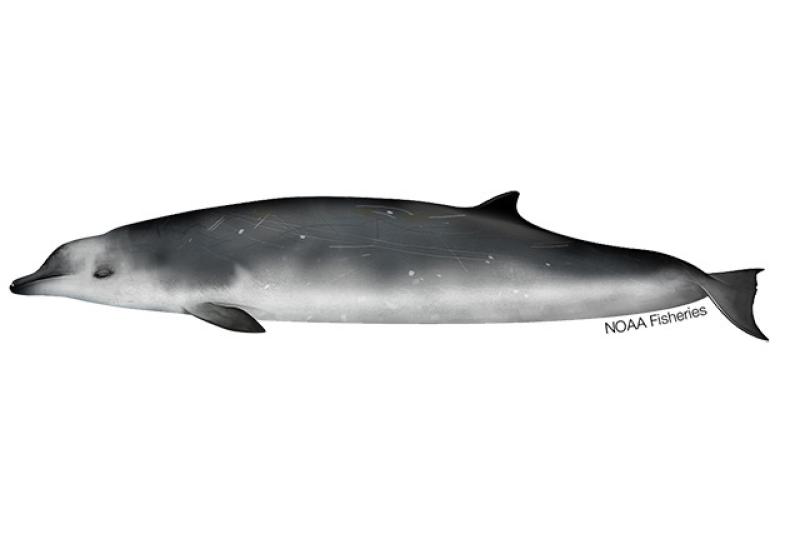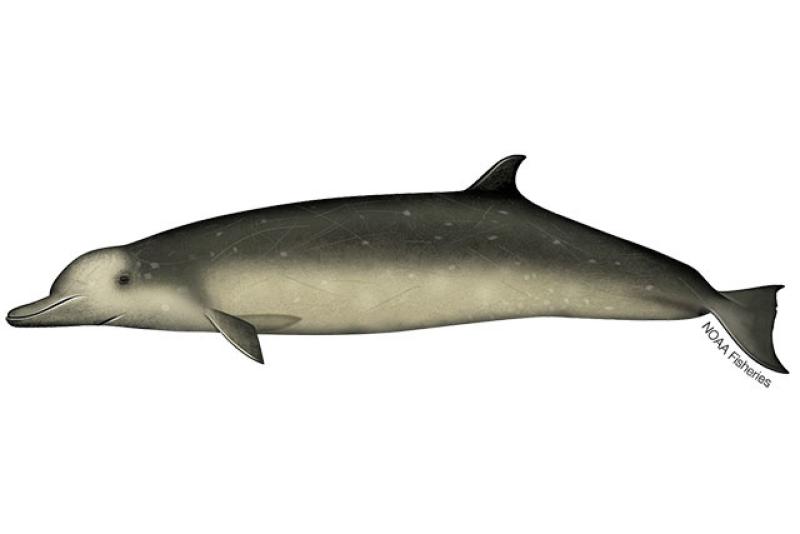Stejneger's Beaked Whale
Mesoplodon stejnegeri
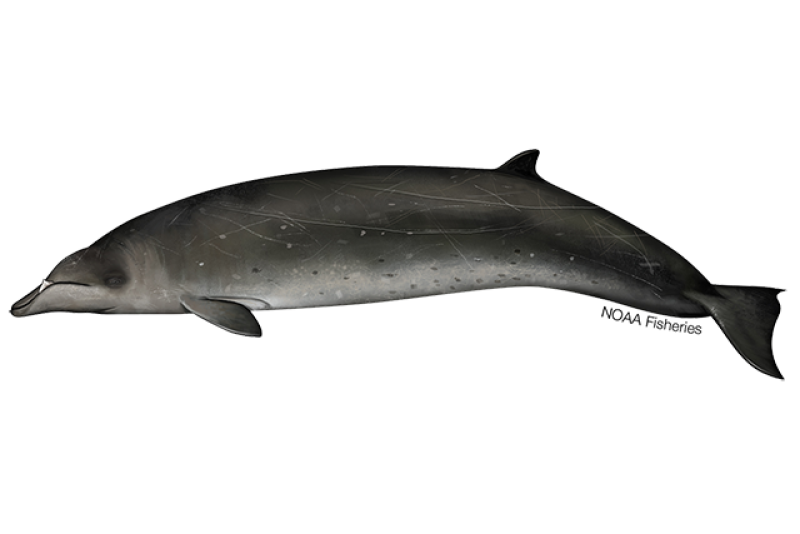
Protected Status
Quick Facts
About the Species
Stejneger's beaked whales, sometimes known as the "Bering Sea beaked whale" or "saber-toothed whale," are little known members of the beaked whale family (Ziphiidae). They receive their common and scientific name from Leonhard Stejneger, a naturalist and curator at the Smithsonian Institution, who first described the species from a single skull discovered on Bering Island in 1885.
This species prefers the cold, temperate, and subarctic waters of the North Pacific Ocean and is generally found in deep, offshore waters on or beyond the continental slope. There is little information on the abundance of Stejneger's beaked whales worldwide due to the rarity of sightings at sea. Overall, the beaked whale family is cryptic and skittish, and individual species lack any easily discernible physical characteristics, making it difficult to distinguish between them.
Although they face threats from entanglement in fishing gear, human-caused noise, and marine debris, Stejneger's beaked whales in the United States are not endangered or threatened. Like all marine mammals, they are protected under the Marine Mammal Protection Act.
Population Status
NOAA Fisheries estimates population size for each stock of Stejneger's beaked whale in its stock assessment reports. A stock is a group of animals that occupy the same area and interbreed. There is little information on the abundance of this species worldwide due to the rarity of sightings at sea. Thus, data are insufficient to estimate population trends.
Appearance
As adults, Stejneger's beaked whales can reach lengths of about 18.7 feet and weigh up to 3,527 pounds. Females may be slightly larger than males. Males can be easily distinguished from females and juveniles by a pair of large, visible, forward-and-inward-pointing, tusk-like teeth that erupt from their arched lower jaw. Females and juveniles also have teeth, but they remain hidden beneath the gum tissue of the mouth, and their jawline is generally less curved.
Stejneger's beaked whales have a relatively medium-sized, round body with a small, wide-based, slightly hooked dorsal fin located about two-thirds down their back. They have a low-sloping, indistinct forehead (known as a melon). Their coloration varies from dark gray to brownish and black. A dark cap that extends across the top of the head from eye to eye, and the lower jaw is usually white or pale gray. The dark cap and light belly are more prominent on juveniles than adults. The ventral surface of the flukes of adults has a series of gray or white concentric lines, radiating from the midpoint of the trailing edge. The skin may be covered with linear and oval-shaped scars and other markings. Individuals, especially mature males, accumulate more scars and scratches with age. Mature males will battle each other for access to females.
Behavior and Diet
Stejneger's beaked whales are usually found individually or in small, tight social groups averaging between five and 15 individuals. These groups may contain animals of mixed sexes, ages, and life stages, or they can be segregated. Like most beaked whales, this species is difficult to approach and generally avoids vessels.
Stejneger's beaked whales usually make five to six shallow dives followed by a longer dive that lasts ten to 15 minutes and may reach depths of 4,920 feet. While diving, they use suction to feed on small deep-water fish, tunicates, and cephalopods (e.g., squid).
Where They Live
Stejneger's beaked whales prefer the cold, temperate, and subarctic waters of the North Pacific Ocean. They are generally found in deep, offshore waters between 2,500 and 5,000 feet on or beyond the continental slope.
Stejneger's beaked whales have a distribution throughout the North Pacific that includes California, the Aleutian Islands, the southwest Bering Sea, Kamchatka, the Okhotsk Sea, and the Sea of Japan. Acoustic detections indicate that Stejneger’s beaked whales are present nearly year around in the northern Gulf of Alaska, with a peak in detections in the fall.
Lifespan & Reproduction
Stejneger's beaked whales may become sexually mature when they reach about 14.8 feet in length. A sexually mature female will give birth to a single calf that is about 7.2 to 8 feet long and weighs about 175 pounds. The calving season is generally between spring and early autumn. The estimated lifespan of this species is at least 35 years.
Threats
Entanglement in Fishing Gear
Stejneger’s beaked whales can become entangled or captured in commercial fishing gear, particularly in driftnet and gillnet fisheries in the Sea of Japan and off the west coast of North America.
Commercial Whaling
This species is hunted in a Japanese fishery that targets beaked whales.
Marine Debris
Stejneger’s beaked whales are known to have ingested dangerous items such as plastic bags and string.
Ocean Noise
Deep-diving cetaceans like Stejneger’s beaked whales use sound to feed, communicate, and navigate in the ocean. Sound pollution threatens them by interrupting their normal behavior and driving them away from areas important to their survival. Anthropogenic loud noise such as active sonar or seismic activity can disorient or drive beaked whales to the surface too rapidly, leading to decompression sickness or death.
Scientific Classification
| Kingdom | Animalia | Phylum | Chordata | Class | Mammalia | Order | Cetacea | Family | Ziphiidae | Genus | Mesoplodon | Species | stejnegeri |
|---|
Last updated by NOAA Fisheries on 01/14/2025
What We Do
Conservation & Management
All Stejneger's beaked whales are protected under the Marine Mammal Protection Act. Our work protects this species by:
- Reducing interactions with commercial and recreational fishing gear
- Implementing requirements to reduce serious injuries and mortalities
- Responding to dead, injured, or entangled Stejneger’s beaked whales
- Minimizing the effects of vessel disturbance, noise, and other types of human impacts
- Educating the public about the threats beaked whales face
Science
Our research projects have helped us better understand Stejneger’s beaked whales and the challenges they face. Our work includes:
- Stock assessments
- Stranding response
- Acoustic monitoring
- Shipboard surveys
How You Can Help
Keep Your Distance
Be responsible when viewing marine life in the wild. Observe all large whales from a safe distance of at least 100 yards and limit your time spent observing to 30 minutes or less.
Report Marine Life in Distress
Report a sick, injured, entangled, stranded, or dead animal to make sure professional responders and scientists know about it and can take appropriate action. Numerous organizations around the country are trained and ready to respond. Never approach or try to save an injured or entangled animal yourself—it can be dangerous to both the animal and you.
Learn who you should contact when you encounter a stranded or injured marine animal
Report a Violation
Call the NOAA Fisheries Enforcement Hotline at (800) 853-1964 to report a federal marine resource violation. This hotline is available 24 hours a day, 7 days a week for anyone in the United States.
You may also contact your closest NOAA Office of Law Enforcement field office during regular business hours.
Featured News

 Rice's Whale. Credit: NOAA Fisheries
Rice's Whale. Credit: NOAA Fisheries
Protecting Species While Planning for Offshore Wind Development in the U.S. Gulf of Mexico
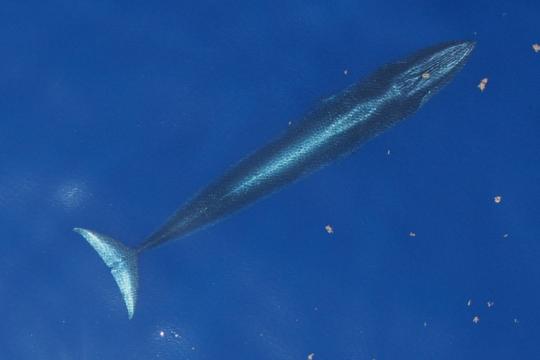 A Rice’s whale just under the surface of the water in the Gulf of Mexico. This endangered whale was recognized as a separate species from the Bryde’s whale in 2021. Credit: NOAA Fisheries under NOAA Permit No. 21938.
A Rice’s whale just under the surface of the water in the Gulf of Mexico. This endangered whale was recognized as a separate species from the Bryde’s whale in 2021. Credit: NOAA Fisheries under NOAA Permit No. 21938.
Celebrate Whale Week with Us: A Message from Janet Coit, Assistant Administrator of NOAA Fisheries
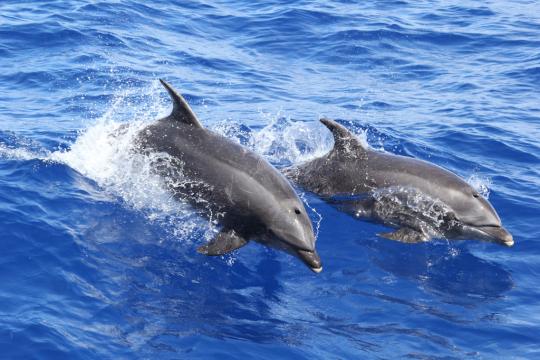 Pair of bottlenose dolphins. Credit: NOAA Pacific Islands Fisheries Science Center/Lisa Morse.
Pair of bottlenose dolphins. Credit: NOAA Pacific Islands Fisheries Science Center/Lisa Morse.
Management Overview
The Stejneger's beaked whale is protected throughout its range under the Marine Mammal Protection Act.
Additionally, the Stejneger's beaked whale is listed under:
- Appendix II of the Convention on International Trade in Endangered Species of Wild Fauna and Flora (CITES)
Conservation Efforts
Reducing Interactions with Fishing Gear
Stejneger’s beaked whales are caught as bycatch in fishing gear, leading to deaths and serious injuries, particularly in the driftnet and gillnet fisheries in the Sea of Japan and off the west coast of North America. NOAA Fisheries is committed to minimizing bycatch in U.S. fisheries to ensure these fisheries remain sustainable and to protect species such as the Stejneger’s beaked whale.
Learn more about bycatch and fisheries interactions
Addressing Ocean Noise
NOAA Fisheries is investigating all aspects of acoustic communication and hearing in marine animals, as well as the effects of sound on beaked whale behavior and hearing. In 2018, we revised marine mammal acoustic technical guidance for assessing the effects of anthropogenic sound on marine mammal hearing.
Overseeing Marine Mammal Health and Stranding Response
We work with volunteer networks in all coastal states to respond to marine mammal strandings including all whales. When stranded animals are found alive, NOAA Fisheries and our partners assess the animal’s health and determine the best course of action. When stranded animals are found dead, our scientists work to understand and investigate the cause of death. Although the cause often remains unknown, scientists can sometimes attribute strandings to disease, harmful algal blooms, vessel strikes, fishing gear entanglements, pollution exposure, and underwater noise. Some strandings can serve as indicators of ocean health, giving insight into larger environmental issues that may also have implications for human health and welfare.
Learn more about the Marine Mammal Health and Stranding Response Program
Marine Mammal Unusual Mortality Events
Stejneger’s beaked whales have never been part of a declared unusual mortality event. Under the Marine Mammal Protection Act, an unusual mortality event is defined as "a stranding that is unexpected; involves a significant die-off of any marine mammal population; and demands immediate response." To understand the health of marine mammal populations, scientists study unusual mortality events.
Regulatory History
Stejneger's beaked whales are protected under the MMPA.
Key Actions and Documents
Last updated by NOAA Fisheries on 01/14/2025
Science Overview
Stock Assessments
Determining the size of Stejneger's beaked whale populations helps resource managers gauge the success of NOAA Fisheries’ conservation measures. Our scientists collect and present these data in annual stock assessment reports.
Shipboard Studies
NOAA Fisheries conducts research cruises to collect information on beaked whale stocks, such as habit preferences and feeding ecology. These studies also help us estimate the abundance of beaked whales. Information from this research can be used in management actions to protect these animals.
Acoustic Science
Our research is also focused on acoustics—the physics of the properties of sound. We study the basic acoustic behavior of cetaceans and fish, mapping the acoustic environment and finding better ways to find cetaceans using acoustic technologies. Our acoustic research also assesses the degree to which human-caused activities are changing the underwater soundscape, how these changes may potentially impact marine animals in their acoustic habitat, and what measures can be taken to mitigate these potential impacts.
More Information
- Big GOALS Accomplished: Surveying for Cetaceans in the Gulf of Alaska
- NOAA's National Marine Mammal Laboratory (NMML) Beaked Whale Information
- Smithsonian National Museum of Natural History Marine Mammal Program Beaked Wha…
- Marine Mammal Permits and Authorizations (scientific research, photography, inc…
Last updated by NOAA Fisheries on 01/14/2025
Research
Killer Whale and Beaked Whale Posters
Art-Science Collaboration Celebrates the Diversity of Killer Whales and Beaked Whales from Around the World
Last updated by NOAA Fisheries on 01/14/2025
